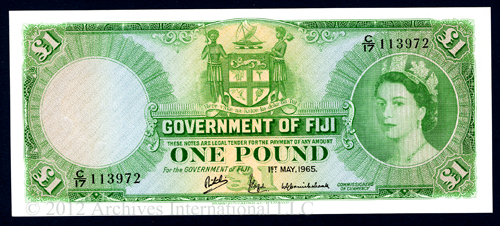
About UsThe Numismatic Bibliomania Society is a non-profit organization promoting numismatic literature. For more information please see our web site at coinbooks.org SubscriptionsThose wishing to become new E-Sylum subscribers (or wishing to Unsubscribe) can go to the following web page link MembershipThere is a membership application available on the web site Membership Application To join, print the application and return it with your check to the address printed on the application. Membership is only $15 to addresses in the U.S., $20 for First Class mail, and $25 elsewhere. For those without web access, write to: David M. Sundman, Secretary/TreasurerNumismatic Bibliomania
Society AsylumFor Asylum mailing address changes and other membership questions, contact David at this email address: dsundman@LittletonCoin.com SubmissionsTo submit items for publication in The E-Sylum, just Reply to this message, or write to the Editor at this address: whomren@coinlibrary.com
BUY THE BOOK BEFORE THE COINYou won't regret it! |
- WAYNE'S WORDS: THE E-SYLUM APRIL 7, 2013
- KOLBE & FANNING BUY OR BID SALE ENDS APRIL 25
- NEW BOOK: ANNOTATED BIBLIOGRAPHY OF ANCIENT GREEK NUMISMATICS
- NEW BOOK: THE ARISTOCRAT: THE STORY OF THE 1793 SHELDON 15
- NEW BOOK: QUICKFINDER FOR VARIETIES OF U.S HALF CENTS, 2ND EDITION
- NEW BOOK: CARTWHEEL - A SEQUEL TO DOUBLE EAGLE
- BOOK REVIEW: JOURNAL OF NUMISMATIC RESEARCH, SPRING 2013
- BOOK REVIEW: ENCYCLOPEDIA OF U.S. SILVER DOLLARS 1794 – 1804
- THOUGHTS ON CLUB MEMBERSHIP AND PARTICIPATION
- QUERY: JOHN WORK GARRETT SENATORIAL RACE INFO SOUGHT
- THE UNIQUE COIN HOLDER
- NOTES FROM E-SYLUM READERS: APRIL 7, 2013
- MORE ON POLITICS AND NUMISMATICS
- KARL GOETZ ORIGINAL DIES AND HUBS OFFERED BY HERITAGE
- QUERY: COLUMBIAN EXPOSITION TREASURY DEPARTMENT EXHIBITS INFO SOUGHT
- THE U.S. MINT'S LASER FROSTING TECHNIQUES
- ARE WATCHFOBS NUMISMATIC?
- ARTICLE HIGHLIGHTS HIGLEY COPPERS
- IRELAND'S NEW 10 EURO JAMES JOYCE COIN
- 1934 ARTHUR HENDERSON NOBEL PRIZE MEDAL STOLEN
- THE MAY 27, 2013 RAPP COIN AUCTION
- DAWSON LEWIS, MEDIEVAL MONEYER OF PIERRE, SD
- ROSARIO SHIPWRECK SITE YIELDS SILVER COINS AND GOLD BARS
- HOW MUCH GOLD IS THERE IN THE WORLD?
- KING OFFA'S PENNY
- WON PARK, MASTER OF MONEY ORIGAMI
- FEATURED WEB PAGE: DAMNATIO MEMORIAE
WAYNE'S WORDS: THE E-SYLUM APRIL 7, 2013

New subscribers this week include Bagrat Sahakyan and Jason Sohigian. Welcome aboard! We have 1,640 email subscribers, plus 222 followers on Facebook.
This week we open with word of the second Buy of Bid sale from numismatic literature dealers Kolbe & Fanning, FOUR new books and two reviews. Next up are thoughts on our recent survey and club membership in general, and an interesting item relating to numismatist John Work Garrett.
Other topics this week include the Unique Coin Holder, Karl Goetz medal dies, the 1964-D Peace dollar, the U.S. Treasury's exhibits at the Columbian Exposition, Higley coppers, damnatio memoriae, and the medieval moneyer of Pierre, South Dakota.
To learn more about watchfobs, coins of the Holy Roman Empire, four-fingered Roman coiners, King Offa's penny, and why striking coins is like eating potato chips, read on. Have a great week, everyone!
Wayne Homren
Editor, The E-Sylum
KOLBE & FANNING BUY OR BID SALE ENDS APRIL 25
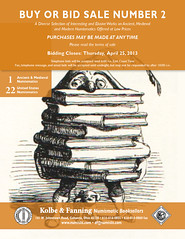 Kolbe & Fanning Numismatic Booksellers have announced their second annual “Buy or Bid Sale,” which will close on Thursday, April 25. The sale is designed to sell hundreds of lots cheaply, giving collectors an opportunity to add to their libraries at inexpensive prices.
Kolbe & Fanning Numismatic Booksellers have announced their second annual “Buy or Bid Sale,” which will close on Thursday, April 25. The sale is designed to sell hundreds of lots cheaply, giving collectors an opportunity to add to their libraries at inexpensive prices.
The sale is online only: there will be no printed catalogue. The PDF catalogue is available now for downloading from the Kolbe & Fanning website at www.numislit.com.
As the name of the sale suggests, customers may bid on items they wish to acquire or buy them outright at the published price. The Terms of Sale will give full instructions on how to participate: please read it carefully.
The sale includes over 500 works on ancient, medieval and modern coins, as well as general works, periodicals and sale catalogues. “Buy” prices have been kept low to promote sales. To further encourage participation, the firm is offering free postage to addresses in the U.S. for bidders spending at least $500; there will also be no packing and processing fee for this sale. Again, please read the Terms of Sale before participating.
If you have any questions about the sale, please write to David Fanning at df@numislit.com. He can also be reached at (614) 414-0855.
Thank you in advance for your participation. Download the sale today: www.numislit.com.
To read the complete article, see: ()
NEW BOOK: ANNOTATED BIBLIOGRAPHY OF ANCIENT GREEK NUMISMATICS
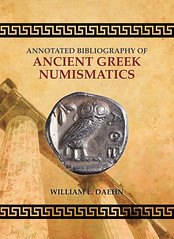 CNG takes pleasure in announcing this upcoming publication. Advance orders are now being accepted. Delivery is expect in early May. This book is being printed in a limited edition of 250 copies only. It is essential for all dealer’s libraries as well as numismatic scholars and serious collectors of Greek coins.
CNG takes pleasure in announcing this upcoming publication. Advance orders are now being accepted. Delivery is expect in early May. This book is being printed in a limited edition of 250 copies only. It is essential for all dealer’s libraries as well as numismatic scholars and serious collectors of Greek coins.
Daehn's book is the standard bibliography on all aspects of Greek coinage. It is a significant expansion of the first edition of his book, as it includes works in all languages, not just English.
Daehn, William E., Annotated Bibliography of Ancient Greek Numismatics. 2013. Lancaster, PA. 600 numbered pp. Hardbound. (GR). (GR351) $175.00
In 2001, William E. Daehn published Ancient Greek Numismatics – A Guide to Reading and Research. A Bibliography of Works Written in English with Summaries of Their Contents. This book has remained an important research tool for the numismatist of Ancient Greek numismatics, since the author included content summaries with each bibliographic reference. Its major drawback, however, has been that the book was limited to citing only English language works, at the exclusion of the rich literature on the subject in non-English. Recognizing the need to include non-English language works into the bibliography, he has been doing so since 2001. The result is the Annotated Bibliography of Ancient Greek Numismatics.
The arrangement of this book is fairly straightforward. Beginning with general references, it then proceeds to works on special aspects of Greek numismatics, and then specific geographic areas. This latter section follows the arrangement traditionally used by catalogers of Greek coinage, moving clockwise around the Mediterranean. Each section or subsection is alphabetical by author, and chronological when an individual author has written two or more works on the same subject. Critical reviews are noted where necessary, and reprints of the same article, as well as the publication country of foreign journals, are noted where applicable. Like Clain-Stefanelli, each entry has been assigned an index number, and a concordance to Clain-Stefanelli is also included. Indexes specifically of authors, reviewers, and collectors and collections, as well as indexes of cities, districts, kingdoms, and tribes, are located at the end of the book.
The most important feature of this book (as well as that of the previous one) is the inclusion of a brief synopsis of the entry’s contents and main conclusions, which allows the researcher and the collector to efficiently conduct their research and supplementary reading. Many of the entries are by the author; those from elsewhere are referenced to their appropriate source.
For more information or to order: http://www.cngcoins.com/Coin.aspx?CoinID=230396
NEW BOOK: THE ARISTOCRAT: THE STORY OF THE 1793 SHELDON 15
 The Aristocrat:
The Aristocrat:
The Story of the 1793 Sheldon 15
This is a rather specialized book. It is about just one of the more than 300 known varieties of early United States cents, which were coined between 1793 and 1814. It is the second-rarest “collectible” variety in the series, with only twelve known.
When coin collecting took off in this country in 1857, the cents of 1793 were considered the most important of the entire series. This particular variety was designated “Sheldon 15” by Dr. William Sheldon in his classic work Early American Cents in 1949. In his 1958 revision of this work, Penny Whimsy, he referred to this variety as “The Aristocrat” because of its rarity and importance.
I acquired my S15 from Kagin’s sale of the Philip Van Cleave collection in 1986. This cent was the discovery coin for the variety, discovered by Sylvester S. Crosby around 1868. Crosby, famous for his epic work on colonial coins, The Early Coins of America, published in 1873, also had a significant interest in the cents of 1793. He wrote the descriptions of the varieties of the 1793 cents that were photographed for Joseph N. T. Levick’s plate of 1793 cents that was published in the April 1869 issue of the American Journal of Numismatics.
Both the obverse and the reverse of my S15 are pictured on Levick’s plate. In 1897 Crosby published a monograph on the topic, The United States Coinage of 1793—Cents and Half Cents. This book is so complete that only one new variety of 1793 has been discovered since its publication, and this only occurred eighty years later.
My motivation for this book began with the pedigree information that was written in the description of lot 5017 in the Kagin catalogue. Most of it came from Dorothy Paschal, a previous owner and “very good friend” of Dr. Sheldon. I found that the majority of this information was incorrect.
This got me started on trying to find out about the true provenance of this cent. It then escalated into finding the auction appearances of all S15’s. I started collecting every catalogue I could find that had an S15. The Dan Holmes sale in 2009 was the twenty-ninth appearance of this variety since its first in 1880.
I think I have written the type of book that I have always wanted to read. It includes the history, folklore, and stories on this rare variety of 1793 cent, and just as Crosby did in 1897, I am publishing it in an edition of 200 copies (However, unlike Crosby's book, it will cost more than $2.00).
NEW BOOK: QUICKFINDER FOR VARIETIES OF U.S HALF CENTS, 2ND EDITION
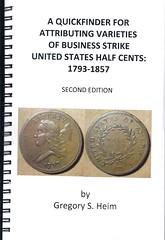 The second edition of "A Quickfinder For Attributing Varieties of Business Strike United States Half Cents: 1793-1857" is now in stock!
The second edition of "A Quickfinder For Attributing Varieties of Business Strike United States Half Cents: 1793-1857" is now in stock!
Shipping for all prepaid orders, and all orders thereafter will commence the week of April 8, 2013.
The booklet is in color. It contains 44, streamlined pages in a 5.5 X 8.5 format printed on quality white paper stock, and it is spiral bound so it will lie flat.
My "Quickfinder" method enables those with limited experience to attribute varieties and die marriages of early type easier and more efficiently.
Copies are $15.00 + $2.50 shipping and handling. If you wish to pay by Paypal, and/or you are interested in purchasing multiple copies, please send me an e-mail at gregheim@njcoinbuyer.com. Please make all checks payable to GREGORY S. HEIM, LLC., PO Box 277, South Plainfield, NJ 07080-0277.
NEW BOOK: CARTWHEEL - A SEQUEL TO DOUBLE EAGLE
 Even after the success of my mystery-thriller, Double Eagle (Peachtree, 2009), I knew I would never write a sequel. Double Eagle follows two 13-year-old boys, Mike and Kyle, as they search for a hoard of Confederate 1861 gold $20 pieces in a Civil War fort in southern Alabama. At the end of the book, the boys part ways, each with one of the coins in his pocket. Although readers demanded a sequel, the improbability of repeating such a numismatic adventure kept me from a second book — until another irresistible premise crossed my desk.
Even after the success of my mystery-thriller, Double Eagle (Peachtree, 2009), I knew I would never write a sequel. Double Eagle follows two 13-year-old boys, Mike and Kyle, as they search for a hoard of Confederate 1861 gold $20 pieces in a Civil War fort in southern Alabama. At the end of the book, the boys part ways, each with one of the coins in his pocket. Although readers demanded a sequel, the improbability of repeating such a numismatic adventure kept me from a second book — until another irresistible premise crossed my desk.
I thank Daniel Carr for fueling my interest in the 1964-D Peace dollar. Until he minted his controversial fantasy version of the coin, I’d never unearthed its history. Once I learned that the Denver Mint had produced more than a quarter million 1964-D silver dollars and then melted them down again, however, I knew that I had to reunite Mike and Kyle.
Although the two central characters remain the same, Double Eagle and Cartwheel travel much different storylines. In Cartwheel, Mike and Kyle look for a coin that really did — and probably still does — exist, instead of a coin that I made up. I also raised the stakes for the two boys. Now, the boys have to find the coin to extract themselves from a disastrous situation. Finally, the book spans much greater geographical and historical territory — territory I naturally had to research in depth.
Research, in fact, has always been one of my favorite aspects of writing both fiction and nonfiction. To research Cartwheel, I traveled to the Denver Mint to get a personalized tour of the facility. I met with Dan Carr to see the amazing coin press he restored. I also corresponded with Michael Lanz, who actually helped mint the Peace dollars in May, 1965. All of this helped feed my own interests in numismatics — interests I’ve nurtured since poring through my parents’ beer stein full of Walking Liberty half dollars and Winged Liberty Head dimes as a child.
To read the complete article, see: Using the 1964-D Peace dollar to mint a new thriller novel (www.coinworld.com/Articles/ViewArticle/using-the-1964-d-peace-dollar-to-mint-a-new-t)
THE BOOK BAZARRE
BOOK REVIEW: JOURNAL OF NUMISMATIC RESEARCH, SPRING 2013
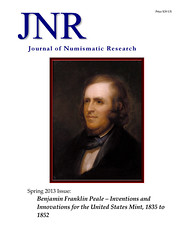 This month we review the
latest edition of Roger
Burdette's Journal of Numismatic
Research. The
current issue, Spring 2013,
is dedicated to Franklin
Peale's technical contributions to the U.S. Mint. By
way of background, Peale was employed by the Mint
from 1833 to 1854, and served as chief coiner from
1839 until the end of his employment.
This month we review the
latest edition of Roger
Burdette's Journal of Numismatic
Research. The
current issue, Spring 2013,
is dedicated to Franklin
Peale's technical contributions to the U.S. Mint. By
way of background, Peale was employed by the Mint
from 1833 to 1854, and served as chief coiner from
1839 until the end of his employment.
Peale's first assignment at the Mint was to survey the European Mints for technological advances, and for this he was dispatched on a two-year journey to the Old World. U.S. Mint Director Samuel Moore was particularly interested in the process of separating gold and silver, and in improving the assay of silver deposits. Peale delivered on this and much more. Burdette does a deep dive into a dozen areas and discusses how Peale introduced any number of improvements into the Mint during this period.
The combination of Moore and Peale was powerful. Moore had spearheaded the construction of the Second Mint "for which the necessary appropriations were obtained chiefly by his own influence and exertions, and which was begun and completed under his immediate superintendence," according to his obituary. Moving from the "old and contracted" building on Seventh Street in Philadelphia to the "spacious and elegant marble edifice" at Chestnut and Juniper Streets was not just a move ahead for the Mint, but a visceral construction demonstrating American capability to the rest of the world. Philadelphians were proud, and images of the second Mint exploded in the literature, whereas images of the first have only recently been clawed out of the archives. Moore had done his part, and now it was up to Peale to bring real technology into a real building.
Peale returned to the Mint in 1835, and met more than a little resistance, including from our own Christian Gobrecht, who is said to have been displeased with a method of reproducing dies introduced by Peale. Peale stood his ground, and is most notably credited by Burdette with the introduction of the toggle press. The collector mindshare surrounding Peale is more typically focused on the steam-powered press, which Peale did indeed introduce, but Burdette finds the toggle technology more remarkable. To be sure, the introduction of steam power simply wasn't applied directly to an existing screw press. A new type of press was needed to properly harness the power of steam, and Burdette sets the record straight.
Peale went on to make advances in all operations of the Mint - as Roger explains it, he reworked the entire process from refining, to rolling, to cutting, to striking and even counting and weighing. For the first time, this entire story can be found in one place. I expected Roger to clean out the National Archives (I was aware that Peale had written a lengthy report on his European tour, but had never gotten around to calling for the document) but he does this and much more. Peripheral resources, especially related to technology and manufacturing, are integrated in Burdette's analysis to full effect.
I have to admit, when I first heard about this work, I was hoping it would include the semi-lurid details about Peale's termination at the Mint in 1854. A report at the time had Peale building whoopee cushions in order to embarrass lady visitors. Be warned, this is a serious book and readers searching for such hijinx are referred elsewhere, most notably to the Richard Sears McCulloh pamphlet, the proceedings of the late director of the mint, in relation to the official misconduct of Franklin Peale, Esq., chief coiner, and other abuses in the mint (1853). In the meantime, those interested in the coining technology surrounding Liberty Seated coinage will have trouble doing any better than this book. I grade this book an MS69, withholding the MS70 grade only because I have just received an advance copy of Burdette's latest book From Mine to Mint, which is even better and will be reviewed in a future column.
This work is available exclusively from Wizard Coin Supply and may be ordered at www.wizardcoinsupply.com/journal-of-numismatic-research/.
BOOK REVIEW: ENCYCLOPEDIA OF U.S. SILVER DOLLARS 1794 – 1804
 The Encyclopedia of United States Silver Dollars 1794 – 1804, 2013,
Q. David Bowers, Stack’s Bowers Galleries, A Spectrum Group International Company,
The Encyclopedia of United States Silver Dollars 1794 – 1804, 2013,
Q. David Bowers, Stack’s Bowers Galleries, A Spectrum Group International Company,
Reviewed by John and Nancy Wilson, NLG
Becoming a numismatist in 1953 Q. David Bowers over the past six decades has excelled in writing books that immediately become best sellers and standard references as soon as they are released. His new book, the Encyclopedia of United States Silver Dollars 1794 – 1804, is hardbound, has 343 pages, and is fully illustrated in color. In 1993, he authored a first edition of, “Silver Dollars and Trade Dollars of the United States: A Complete Encyclopedia.” That reference helped to set the standard for Silver Dollars and Trade Dollars. Now, 20 years later, Q. David Bowers has once again authored a reference on early Silver Dollars that will be a best seller and wildly popular in the numismatic hobby. Before you even get to Chapter One, you will read starting with his Style Notes which will cover such things as how he uses “Certain original articles;” His “footnotes;” and most importantly “Grading.” The two page “Acknowledgments,” which also covers the First and Second Editions lists some of the leading collectors, dealers and numismatic organization’s and institutions in the numismatic hobby. A “Special Contributor” to the reference is noted author and numismatist, R. W. Julian.
The well done “Foreword” by Martin A. Logies, who is a collector, researcher and Director & Curator for, The Cardinal Collection Educational Foundation. Mr. Logies talks about how at an auction he passed on the opportunity to bid on a truly choice “AU” example of a scarce variety (BB-93) dated 1798. “But, lacking Dave’s book (First Edition), I did not realize just how extraordinarily rare that one coin was in such choice condition, and did not pursue it, choosing to wait for another.” Fifteen years later no specimen of that variety or comparable quality has appeared, and he says “Unknowingly, the opportunity had been squandered.” He talks about what happened after purchasing the first edition and how his collecting improved.
The “An Appreciation” was done by Warren Miller who began collecting in the era right before PCGS and NGC began certifying coins. He talks about the value of this new updated reference regarding these and others: The historical information and up to date auction records. How the photography would be a valuable tool attributing die varieties and die states. He finishes by saying, “It was a pleasure and a privilege to participate in this book by both editing and supplying photographs as needed.”
The author's “Introduction” explains how this reference was consolidated from his first to this second edition. He thanked R. W. Julian, for creating a truly great historical overview and Walter H. Breen (deceased) for providing technical notes on die varieties. In 2012 this present second edition was created and quoting “this being a revision and updating of the information on the early series of Flowing Hair and Draped Bust Dollars from 1794 to 1804.” “Offered in a single volume with much new information, including updated rarity data, color pictures, and state-of-the-art knowledge, this book will be your passport to one of America’s most interesting coinage specialties.” The author goes on in this introduction to explain changes in the marketplace, the certification process and several important collections that have been dispersed over the years. This one page “Introduction” is a perfect set-up to the 18 chapters that follow.
Chapter 1: Early Silver Dollars 1794 – 1804. Historical Background. Numismatic expert R. W. Julian summarizes the need for a larger coin than just the simple penny. Mr. Julian takes you on a journey from the fall of Rome in the 5th century, coinage prior to Charlemagne, Europeans need for a larger coin than just the simple penny right up to Archduke Sigismund of Tyrol who in 1486 struck to first dollar-sized silver coin. Other topics covered include Federal Mint proposals and authorizations; David Rittenhouse; the beginning of regular coinage; how dies were made; creating the 1794 Dollar dies, technical matters – assaying and coining from 1796 to 1803.
Chapter 2: Aspects of Collecting Early Dollars. Early silver dollars of the 1794– 1803 were made in three distinct design types and well over 100 die varieties. Some important tables from famous numismatists will also be found in this chapter. The Bowers-Borckardt (BB) Numbers are also explained.
Chapter 3: Rarity and its Relation to Price. The Universal Rarity Scale (URS) from URS 1 TO URS 14 is shown, along with the Population Estimates from G-4 to MS-65 or better. Estimated Condition Census along with Rarity vs. Price (the factors affecting pricing) are also analyzed.
Chapter 4: Characteristics of Early Dollars and Dies. Die states and characteristics along with the sequence from die state 1 to die state VI are explained. Explanations are giving for the different die states such as, Die finishing marks, Repunching marks, Die cracks & clashing, Resurfacing or relapping and others. Bolender’s term of Bifurcated is also explained. Changing Die States explains how over a period of time a die went from few flaws to later how it began to fail. A “hypothetical variety of early dollar, a sequence of die states might have a history as this.” Die State l: Perfect obverse and reverse dies. No Cracks. To Die State Vl which would be the later state of the dies. More explanations are giving for the various die states. Die Combinations, Coin and Striking Defects and Overdates close out the chapter. Some great close-up photographs of some of the die characteristics are shown.
Chapter 5: Easy-Finding Guide to Early Dollars. All the BB numbers are listed by date and type. Each is described in great detail. This “Guide is intended to make it easy to attribute a given dollar to a BB number.” Photos of the obverse and reverse of dollars from 1794 to 1803 are depicted, along with an easy to use guide for attributing your coin(s) for each one.
Chapters 6 through 17 cover the dollars with each date being covered by one chapter. Each BB number is listed and described in great detail. Die states are also described and notable examples of each are identified along with a pedigree and in some case the selling price at the time of sale. The total estimated population by grade as well as condition census grades is given. Charles Opitz, who is our relative, used the book to identify three pieces in his collection. He mentioned to us he found the book to be easy to use and the detail in the book made the identification accurate.
Chapter 18: Historical Market Prices for Early Dollars. This chapter starts with the A. C. Kline Collection sale in 1855 and lists all the pieces in that sale along with condition and selling price. From the Kline collection sale in 1855, all the important sales of early silver dollars is covered (along with most selling prices) right up to the sale of the Cardinal collection sale in 2005. A wonderful survey of, “the advance of values,” from the 1850s, to modern times through the sales that are listed.
Appendix l: Errors and Curiosities. This section lists the double and triple strike pieces. The author talks about the early mint and their focus “on the efficiency and economy of production,” which consequently caused worn out dies to be used over and over again. Some of these errors are illustrated in this reference.
Appendix ll: Early Silver Dollars in the National Numismatic Collection. All of the early dollars in the Smithsonian Collection are listed by BB number, date and condition. The list was compiled by ANA Governor and Dealer Jeff Garrett with assistance by Smithsonian Numismatic Collection Senior Curator Dr. Richard Doty and Curator Karen Lee.
The Bibliography (and Source Notes) along with the Index close out the reference.
With the recent auction price of over Ten Million for a 1794 Silver Dollar, we can see more interest in these early issues of silver dollars. This is a book for all seasons and highly recommended for dealers, collectors, researchers, investors and libraries. The reference is well done, scholarly, has excellent photos, information that is obtainable no-where-else and authored by one of the finest numismatic writers of our (or any time).
The coordinator of this book project was Christine Karstedt who said, “This is a must-have reference book for anyone just developing an interest in early dollars or those who already possess a serious interest in the subject.” Joel Orosz found only one mistake in the book which is mentioned in a past E-Sylum review. On page 22 the number 150 should have been placed after “than.” The reference is available for $39.95 (plus $10 postage and handling) from Stack’s Bowers Galleries, Silver Dollar Book, P. O. Box 1804, Wolfeboro, NH 03894 or phone (866) 811-1804 or Email Melissa Karstedt mkarstedt@stacksbowers.com
THOUGHTS ON CLUB MEMBERSHIP AND PARTICIPATION
Last week I referred to an 175 million estimate of the number of "coin collectors" in the United States. David Ganz quoted a 2002 press release saying that "United States Mint research shows that 139 million Americans are collecting the new quarters".
As for our readership survey, someone asked if we really had no readers in certain U.S. states. Well, all we can really say is that no one claiming to be from those states responded to our survey. It's only a subset of our readership. Since we have several confirmed responses claiming to be from California, we can be pretty sure of the minimum numbers there. But having no responses to report from a state isn't enough to indicate anything except that we likely have a low readership there.
Another twenty-some responses have come in this week. They don't change the overall numbers much, but we now do have confirmed readers in additional states such as Georgia.
Darryl Atchison writes:
I wanted to share some comments about the survey. The results are interesting... and given that it only took about 30 seconds to complete, I am still somewhat surprised at the small (12%) response rate.
I found the comments regarding NBS membership or subscribership to The E-Sylum very interesting. There have probably been debates about the subject of attracting new members to numismatic groups for as long as these groups have existed.
I note with interest the 30,000 ANA membership number (which I assume means is a fairly static number). Certainly 175M collectors sounds a little far-fetched to me. People who put coins into jars after traveling abroad can't really be counted as collectors.... can they?
On a more serious note, I remember conversations we had years ago (probably 15 years ago) about attracting members to the (then) Canadian Numismatic Association.
The Royal Canadian Mint has been recruiting members for the C.N.A. for a long, long time and there have been years when they have attracted over 1,000 new members. But most of these people leave after 1 year. Why? Because they weren't really coin collectors (or certainly not numismatists) in the first place. They were interested in purchasing non-circulating, legal-tender Mint products that were attractive and may have had some nominal historical value.
I also suspect that when they found that they were not entitled to discounts off of these products (as a CNA member) they decided not to renew their membership in the Association.
In a nutshell, the issue has never been how to attract members really.... it's about how to attract the right members!
In our case, the NBS wants to find people that are interested in numismatics, numismatic literature... and, hopefully, numismatic research. Or alternatively, the NBS should be attracting people who don't fit rigidly into those categories and changing their interests so that ultimately they do fit in.
I think that NBS (and E-Sylum) membership may be low because the group fills a very specific niche. Also, people may think that we're simply book collectors... which isn't the case for most (if not all) of your subscribers.
But does that mean that we are doing something wrong? I don't think so! My contention has always been that if there are two people in the world who are interested in 'four-fingered Roman coiners named Brian', they will ultimately find each other if they are actively involved in the hobby. Actively involved being the most important words, here! Likewise, anyone who is seriously interested in our three core interests will find the NBS as well. Of course, we still have to make ourselves accessible and inviting to attract those people.
I want to stress that this is not meant to sound elitist or snobbish. Quite the opposite, in fact. I bet you most people who get your newsletter don't know or care who the other people are who get The E-Sylum or what they do for a living, etc. (except for the few high-profile figures who are prominent in numismatics in a public way). No one really cares what we all do.... just that we share common interests and want to share that knowledge and continue to learn ourselves.
Anyhow, that's my two cents on this topic.
To read the earlier E-Sylum article, see: FIRST E-SYLUM READER SURVEY RESULTS (www.coinbooks.org/esylum_v16n13a02.html)
QUERY: JOHN WORK GARRETT SENATORIAL RACE INFO SOUGHT
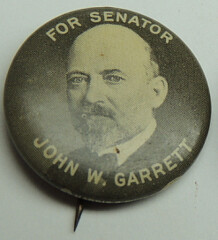
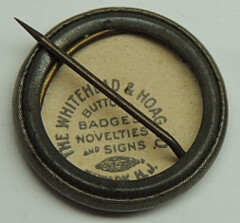
Alan V. Weinberg writes:
Recently seen was a John Work Garrett for Senator celluloid political 7/8" pinback. Garrett of course was the main architect of the extraordinary Johns Hopkins University numismatic collection - likely the finest quality American coin, token and medal collection ever formed - sold by Bowers and Ruddy 1979-1981 in four parts.
Was Garrett's one-time and presumably unsuccessful foray into the political arena previously known to the hobby?
THE BOOK BAZARRE
THE UNIQUE COIN HOLDER
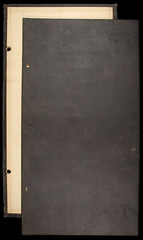 Seeing the images of Colonel Green's collection ledgers in The E-Sylum prompts me to write about another treasure that was held by the Eric P. Newman Numismatic Education Society (EPNNES) but won't be receiving a lot of attention. I began writing to Eric about a year ago inquiring about any vintage coin album materials that he might have that were associated with Colonel Green, since Eric had been quite involved in the dispersal of that collection 70 years ago. After several rounds of correspondence, and after sending Eric the manuscript for my book on the coin holders published by The Beistle Company, from which Green had bought hundreds of Unique Coin Holders and accessory covers, Eric found what I was most seeking.
Seeing the images of Colonel Green's collection ledgers in The E-Sylum prompts me to write about another treasure that was held by the Eric P. Newman Numismatic Education Society (EPNNES) but won't be receiving a lot of attention. I began writing to Eric about a year ago inquiring about any vintage coin album materials that he might have that were associated with Colonel Green, since Eric had been quite involved in the dispersal of that collection 70 years ago. After several rounds of correspondence, and after sending Eric the manuscript for my book on the coin holders published by The Beistle Company, from which Green had bought hundreds of Unique Coin Holders and accessory covers, Eric found what I was most seeking.
Unlike The National Coin Album, Wayte Raymond's successor to the Beistle product, the Unique Coin Holder did not have a binder. Instead, the pages were covered by two separate panels that were linked to the pages with round, steel rings. I have a number of the 1927-30 Unique holders, and I was able to photograph several others at The Beistle Company in Pennsylvania, but I've never been able to locate any of the Beistle covers. A few weeks ago a package arrived from Eric that included two pair of these covers that are presumably remnants of Green's vast holdings of Beistle products. These were a gift, but I was more than pleased to make a donation to the EPNNES in exchange. So far as I know, these are the only survivors of a once very popular item, though others may be lurking unidentified among the junk that accumulates in the typical coin shop back room.
I'm attaching photos of one pair of panels taken by Doug Placensia of NGC. This will be included in my book on Beistle, Raymond and Meghrig coin albums which is perhaps 80% complete at this point. I was hoping to have it for the ANA convention in Chicagomont, but the color photography and layout process is complex enough that it probably won't be in print until later this year.
To read the earlier E-Sylum article, see: B. G. JOHNSON’S LEDGER: NEWMAN DOLLAR PATTERNS (www.coinbooks.org/esylum_v16n13a12.html)
NOTES FROM E-SYLUM READERS: APRIL 7, 2013
PayPal Accepted for Greek, Semitic, Asiatic Coins Book
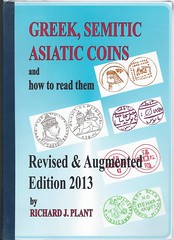 Fred Liberatore reports that author Richard Plant can now accept PayPal payments for his new book, Greek, Semitic , Asiatic Coins and How to Read Them: A Revised and Augmented Edition. Our E-Sylum announcement last week generated several orders, so get 'em while they last.
Fred Liberatore reports that author Richard Plant can now accept PayPal payments for his new book, Greek, Semitic , Asiatic Coins and How to Read Them: A Revised and Augmented Edition. Our E-Sylum announcement last week generated several orders, so get 'em while they last.
To read the earlier E-Sylum article, see: NEW EDITION: GREEK, SEMITIC, ASIATIC COINS AND HOW TO READ THEM EDITION (www.coinbooks.org/esylum_v16n13a05.html)
More on Curved Coins
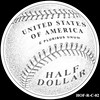 Regarding the curved U.S. baseball commemorative coin mentioned last week, Joe Boling reminds us that we discussed a few earlier curved coins last September when the baseball coin was first announced. Predating the baseball coin were the Royal Australian Mint's Crux Silver Proof, and France's 2001 silver coin commemorating The Last Franc.
Regarding the curved U.S. baseball commemorative coin mentioned last week, Joe Boling reminds us that we discussed a few earlier curved coins last September when the baseball coin was first announced. Predating the baseball coin were the Royal Australian Mint's Crux Silver Proof, and France's 2001 silver coin commemorating The Last Franc.
To read the earlier E-Sylum articles, see:
MORE ON CURVED COINS
(www.coinbooks.org/esylum_v15n37a11.html)
WILL BASEBALL COIN THROW MINTING TECHNOLOGY A CURVE?
(www.coinbooks.org/esylum_v16n13a16.html)
April Fool, 2013
Dave Bowers writes:
I enjoyed both April Fool’s articles—the one about the Mint dies and the one about the WalMart copying machine!
Darryl Atchison writes:
Love the article about the counterfeiter! Reminded me of the bank robber who got stuck in the cubicle between two security doors while trying rob a bank....
Dave Bowers adds:
As in the yearly Darwin Awards! I remember one incident in which a crook stole money and then asked the teller to deposit it in his account. This could have been April 1st too! Truth can be stranger than fiction in numismatics!
David Pickup of the U.K. writes:
You may have heard that Europe is taking up the idea of distributing coins. The leaders of Germany, France and other European Countries will hand out specially minted Euro coins marked with the 1 April date. They will be giving them to deserving causes like bankers.
Enjoy Maundy Euro day
To read the earlier E-Sylum articles, see:
MINT ENDORSES PRIVATE COINAGE WITH ITS SURPLUS DIES
(www.coinbooks.org/esylum_v16n13a17.html)
COUNTERFEITER RETURNS PRINTER WITH FAKE NOTES INSIDE
(www.coinbooks.org/esylum_v16n13a26.html)
Where's George
O. T. Thompson writes:
I've been a Georger almost since its inception and I must tell you about my favorite 'hit'. Living near Camp LeJeune, North Carolina, we see our share of Marines. A few years ago, I began giving a couple of Georgies to Marines I'd see who were getting ready to deploy around the world. All I asked is that they spend them as far away from North Carolina as possible.
That being said, my very best hit read..."Received in change from a smoke shop in downtown Baghdad." I might add that all my Georgies are also stamped with a Viking ship, which I began around 2000 to commemorate their discovery of America...500 years BEFORE Columbus!
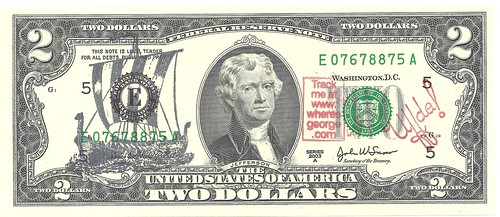
To read the earlier E-Sylum article, see: NPR EXAMINES THE SCIENCE OF 'WHERE'S GEORGE?' (www.coinbooks.org/esylum_v16n13a18.html)
A George Lovett Easter Medal
Here another item on the Easter medal theme. This is the only one I have seen and although not signed by George H. Lovett I have tentatively attributed it to him because of the association of both dies to others attributed to him. If any of your readers know anything about this I would love to hear from them. It is on my website also - http://lovetttokensmedals.com/Churchtokens.html.
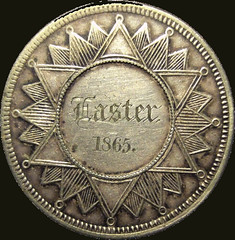

To read the earlier E-Sylum article, see: MORE EASTER-THEMED COINS AND MEDALS (www.coinbooks.org/esylum_v16n13a27.html)
Query: Reed Hawn Sale Hammer Price Sought
Via Facebook Bob Meztger writes:
I wonder if one of you kind souls might be able to help me out with a PRL question. I have an 1803 US Large Cent that I purchased as all or part of lot #1112 in Stack's Auction Sale of December 1, 2, 1993 entitled "United States Coins And Paper Money Featuring Additional Selections From The Reed Hawn Collection." I don't seem to have a copy of the catalog any longer, but I do have the coin, and I don't have a record of the price I paid for it.
I called Stack's and they have thus far been unable to help me - they say they are unable to find a record of any such sale! But I see one on AbeBooks, and my notes with the coin are clear... except for the dollar amount I paid. Can anyone help me out? Thanks!
Quick Quiz: Find That Whale!
If anyone can answer this I'll be really impressed. John Kraljevich's ad last week pictured a close-up image of a whale. I wondered what coin or medal this was taken from. Does anyone know? Any guesses?

MORE ON POLITICS AND NUMISMATICS
John Burns writes:
I was taken aback by the crazed attack on the messenger by Rick Witschonke. Rich Bottles REPORTED this item, he didn't seem to be producing them. The inappropriate thing is Witschonke seems to think that only what he believes is worthy. There is a LONG history of items being used for political purposes. I believe that the rhetoric that was bandied about President Bush was MILES above the fairly innocuous phrase used on this note.
Jeff Kelley writes:
In regard to the feedback (or should I say “blowback”) on the piece on the anti-Obama slogan written on a dollar bill, I fully understand and respect the opinions of those who might disagree with this or any other particular political message, but I think their reactions might be a bit misplaced and in some cases perhaps a bit hypocritical, even if unintended.
As I recall, an article some months ago detailed the stamped dollars being circulated by the “Occupy Wall Street” crowd, and I do not remember the same sort of outcry. It could be argued that the OWS messages did not mention a specific candidate or politician by name, but we were in the run-up to a Presidential election season and the battle lines were clearly drawn in regard to who supported or did not support that political movement.
Coins or currency that have been emblazoned with a political message are highly collectible and historically significant. As a collector, I have been happy to add examples to my collection regardless of the political sentiments being expressed.
I am completely and enthusiastically in agreement with our Editor’s assertion that “… the fact that this is a contemporary numismatic item is all the more reason to discuss it now. I've said again and again that the time to collect and document ephemeral numismatic items is here and now, in the present. There will never be a better time. “
Jan Monroe writes:
If I write something obscene about a republican political figure on a dollar bill will you publish it?
Howard A. Daniel III writes:
I agree that with several people I have corresponded with that the political propaganda "Obama Sucks," on a dollar note is not appropriate for The E-Sylum. But does anyone know the origin of "that sucks" or "he sucks," etc.?
When I was a young man in the Army many years before the Vietnam War, I was trained as a member of a team of about a dozen men and acquired the military occupational skill of Infantry Reconnaissance & Intelligence Specialist. During the training, we were taught how to use current and old weapons. If we ran out of ammunition with our weapon and picked up something from the enemy, we would be able to effectively use it. One of my mentors was my First Sergeant, a combat veteran of World War II and the Korean War, and he taught us how to use many US and foreign weapons from World War II.
When one of the men commented "that sucks" when a weapon jammed, the First Sergeant asked us if we knew where that saying came from? No one knew. He told us that starting in World War II, when a man was hit in the chest and it included the lungs, the chest and lungs would fill up with blood and there was a sucking sound coming from the one or more holes. It was called a "sucking" chest wound. When a medic or someone working on the wounded man and heard the sucking sound, he knew the man would not make it because he did not have the skills and medical supplies to help him. So when it was determined that the man's wound was a sucking chest wound, he would give him some morphine, if available, to dull the pain and comforted him until he died.
Now you know where "sucks" comes from. I bet there is not one in a million people who know this so you are now in rare company.
To read the earlier E-Sylum article, see: ON POLITICS AND NUMISMATICS (www.coinbooks.org/esylum_v16n13a11.html)
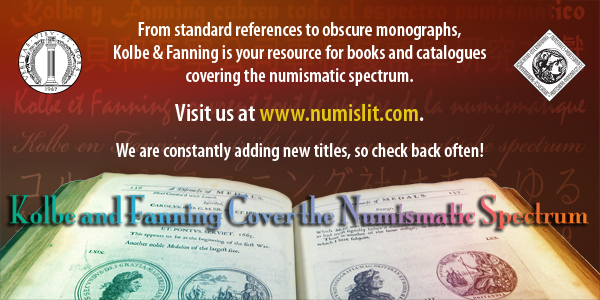
KARL GOETZ ORIGINAL DIES AND HUBS OFFERED BY HERITAGE
 The first of more than 1,200 original dies and hubs cut by satirist and engraver Karl Xaver Goetz, one of Germany’s most prolific medal artists of the 20st century, will be offered without reserve beginning April 17-22 at Heritage Auctions’ World & Ancient Coin Signature® Auction during the Chicago International Coin Fair (CICF).
The first of more than 1,200 original dies and hubs cut by satirist and engraver Karl Xaver Goetz, one of Germany’s most prolific medal artists of the 20st century, will be offered without reserve beginning April 17-22 at Heritage Auctions’ World & Ancient Coin Signature® Auction during the Chicago International Coin Fair (CICF).
Goetz is perhaps best known for engraving the famous 1915 Lusitania medallion commemorating the sinking of the British ocean liner by German torpedoes. His medals later gained notoriety through their artistry and biting criticism of war, with often controversial and polarizing results.
 As a member of the Munich Artists Society, The Numismatic Society, and The Austrian Association for Numismatics in Vienna, Goetz medal artistry was known worldwide. Many of his works are still on display at the Kaiser Friedrich Museum in Berlin, among others. The first selection of dies offered by Heritage will features those crafted for both government and commissioned works, including the die used by Goetz to famously promote anti-black sentiment in the 1920s. His “The Watch on the Rhine” aka “The Black Shame” medal is infamous for using racial overtones to protest black colonial French troops.
As a member of the Munich Artists Society, The Numismatic Society, and The Austrian Association for Numismatics in Vienna, Goetz medal artistry was known worldwide. Many of his works are still on display at the Kaiser Friedrich Museum in Berlin, among others. The first selection of dies offered by Heritage will features those crafted for both government and commissioned works, including the die used by Goetz to famously promote anti-black sentiment in the 1920s. His “The Watch on the Rhine” aka “The Black Shame” medal is infamous for using racial overtones to protest black colonial French troops.
“The dies and hubs will be offered in order as they appear in Gunter W. Kienast’s opus ‘The Medals of Karl Goetz,’” said Cristiano Bierrenbach, Executive Vice President of International Numismatics for Heritage. “Goetz’ remarkable dies are a testament to his talent as well as the important, yet tumultuous, events during which he cultivated his fans and critics.”
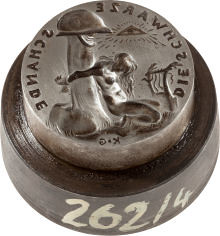 The entire collection will be offered in three parts: The first, April, 17-22, 2013 during Heritage’s World and Ancient Coins Signature® Auction at CICF in Chicago. Future selections will be offered again in September 2013 with the final selection offered in April 2014.
The entire collection will be offered in three parts: The first, April, 17-22, 2013 during Heritage’s World and Ancient Coins Signature® Auction at CICF in Chicago. Future selections will be offered again in September 2013 with the final selection offered in April 2014.
To read the complete article, see:
Heritage Auctions to offer more than 1,200 original dies and hubs from engraver Karl Goetz
(www.coinweek.com/auctions-news/heritage-auctions-to-offer-more-than
-1200-original-dies-and-hubs-from-engraver-karl-goetz/)
Dale Krueger writes:
I'd like to get some reader response and discussion over the latest Heritage auction coming up April 18-23. Specifically, the mysterious appearance of 500 or so hubs and dies of hundreds of Goetz medals.
When I saw these items being offered in the upcoming auction, with no explanation or information attached, I was at once intrigued, puzzled, and horrified. All attempts to get additional information from dealers both here and abroad (by me and some cohorts) were met with either no response, no information to share, apparent total lack of understanding of the issue raised, and/or seemingly total apathy.
A careful reading of the second paragraph from the bottom of page 2 of THE MEDALS OF KARL GOETZ by Kienast, is very clear.
"Unfortunately, hundreds of metal molds and steels dies, which had been stored in the Hauptmunzamt in Munich, were rendered unserviceable by the bombings of World War II, thus rendering duplications of many medals impossible."
Perhaps this industry/hobby would be better served if more questions were asked, more information was shared with collectors, and certain issues were brought "into the light".
One German connection quoted a major Auction official saying "20% of all coins and medals on the market are not original, but this is not so important, if nobody knows!" My connection added, "I cannot work this way, but what´s one to do ?"
I did see someone START to address the "Chinese Problem " in the last issue of The E-Sylum. I am not an expert....but some of you who are should be asking questions, and demanding answers....even if it doesn't yet affect your collecting niche.
QUERY: COLUMBIAN EXPOSITION TREASURY DEPARTMENT EXHIBITS INFO SOUGHT
I'm doing some research on the 1893 Columbian Exposition. The Treasury Dept, via the mint and the Bureau of Engraving/Printing had exhibits on display. I seem to vaguely recall seeing a picture what showed the exhibit but have not had any success in re-discovering where I'd seen it or locating any such pictures on-line (yet!). I wonder if anyone might recall seeing something like this in a book or another resource and can let me know where I might be able to obtain a digital copy? I'm also looking for a possible list of what might have been in the exhibit.
Also, there appears to be an album in the Library of Congress placed there by the Treasury Department in 1910 that contains 30+ pictures of the exhibits in the Government Building at the exposition. However, it's not digitized so one has to go to the LOC pictures room and request/view it. I'm wondering if it might be in this album, but I've got no way to get there. Would anyone in the Washington area be interested in checking this out?
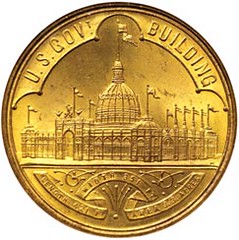
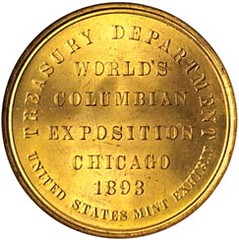
To read the complete article, see: WORLD'S COLUMBIAN EXPOSITION (www.so-calleddollars.com/Events/Worlds_Columbian_Expo.html)
THE U.S. MINT'S LASER FROSTING TECHNIQUES
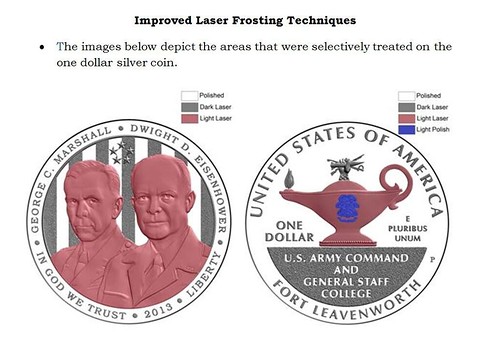
The United States Mint has released the details of a new frosting technique that it will be applying to proof commemorative coins. The first coins to receive this new proof finish are the 2013 5-Star Generals Commemorative Coin Proof Silver Dollar and The 2013 5-Star Generals Commemorative Coin Proof $5 Gold Coin. The previous method of applying laser frosting to the dies in order to achieve the cameo contrast resulted in very grainy surface that in effect destroyed some of the design's finer details. This new process selectively paints the die with varying degrees of frost that is applied via a high-powered laser.
The image on the left shows the areas on the new 2013 5-Star Generals Commemorative Coin Proof Silver Dollar that received the different types of finishes. The reverse on the coin illustrates this best because it uses four different types of finishes. The field (white) is highly polished using felt polishing pads. The lettering, foreground and some design elements (gray) are dark or heavily frosted. A light, not so grainy, frosting is used on the lamp (pink), and the crest on the lamp is accentuated by using a light polishing (blue).
To read the complete article, see: U.S. Mint Introduces New Laser Frosting for Proof Coins (coins.about.com/od/uscoins/tp/US-Mint-Introduces-New-Laser-Frosting-For-Proof-Coins.htm)
Archives International Auctions, Part XIV
Auction Update - Archives International Live
Save the Date
Tuesday, April 16th, 2013
in Fort Lee, New Jersey
ARCHIVES INTERNATIONAL AUCTIONS, PART XIV
Rare U.S. & Worldwide Banknotes, Scripophily and Security Printing Ephemera Including Additional Selections from the Hamtramck Collection, another offering from the American Bank Note Commemoratives Inventory as well as Properties of Banknotes, Coins and Scripophily from various consignors.
Included will be over 1000 lots of Rare Worldwide Banknotes, Coins and Scripophily. Please view our website for auction updates
Fort Lee, NJ 07024
Phone: 201-944-4800
Email: info@archivesinternational.com
WWW.ARCHIVESINTERNATIONAL.COM
ARE WATCHFOBS NUMISMATIC?
Now, I know what some of you are thinking - "What the heck is a watch fob?" First, I suppose, I may have to explain what a 'watch" is. It's an old fashioned timepiece carried in a pocket or worn on a wrist. Pre-electronic era, they ran on energy stored up inside the housing by physically winding a stem on the watch - no batteries or photocell required. Pocket watches were often secured by a small chain. Sometimes an ornament or seal was attached the watch chain. These were called "watch fobs" or "watchfobs". Below is an image of an early Mercedes automobile advertising watch fob.
Sorry if this reads like sarcasm to many of you, but the younger generation may truly require some background explanation. I know this because my kids tell me things like "There's always been an Internet" and "There've always been cell phones". -Editor
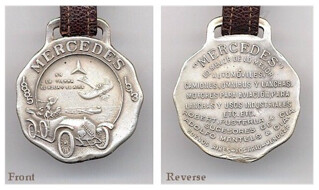
I visited a museum this week and asked to see the items in one particular display case -- a group of colorful watchfobs. I do this frequently when visiting a new museum. I get turned down perhaps half the time, but I found in small museums, particularly when I can ask permission from the top honcho permission is granted. It is worthwhile to ask even for success half the time.
My son and family were visiting for Easter week. Six-year-old grandson is fascinated with trains. When a train museum was mentioned it became a unanimous choice for a family visit.
Tucked in a corner I found the display of 32 watchfobs, every one in colorful enamel of a different railroad. All save for one, it was Clabber Girl baking power. I asked the attendant for permission to examine each of these to see if they were signed by a maker on the reverse.
"I can't grant permission, but the chairman is in the train yard I will go ask him." In the past I have dealt with directors, chief curators and others, but this was a first. I had to get permission from the chairman.
Minutes later he arrived. After introductions and a brief recital of my credentials and the reason why I wanted to see the reverse of each of those watchfobs, he became enthused to learn more about the watchfobs himself.
Fortunately a worktable was in the center of the room and they brought me a handful, all 32 watchfobs, to examine. I turned over the first to find a large inscription: "A CLASSIC ISSUE."
Strange I thought, but the second and all the rest bore the same inscription (except for Clabber Girl). Then I realized these were all reproductions, copies, not originals.
"These are all reproductions" I informed the chairman. "Worth less than $100. If they were genuine they would be worth between $1,000 and $1,500."
"I don't care about value. They make a good display." On that point he was correct. With train logos, famous railroad names, and color enamel they were excellent showpieces.. Evidently the donor thought that as well. He had one watchfob (Clabber Girl) admixed in a group of 31 railroad items.
Which brings me to my question: Are watchfobs numismatic? I lean to saying "yes." They are diestruck, made by the same companies (usually) who are also private mints or medal makers. Same engravers, struck on same presses, same metal compositions (even silver and gold!). Often given a finish similar to medals.
Most watchfobs are uniface (only the side exposed). They must have a wide loop at the top for the leather strap (called a fob loop). I have never seen one signed by the original artist, but frequently signed by the maker (name or logo). Whitehead & Hoag in Newark, Greenduck of Chicago, Robbins and Metal Arts were all major manufacturers. Tiffany & Co made one in 1881. Watchfobs were often sold or given away at expos, fairs or conventions.
They were highly popular in the 1890s which continued to the 1930s. All men's pants had a small pocket below the belt. That's where the owner kept his pocket watch. The fob was connected to a leather strap connected to the watch. To retrieve the watch it was an easy task via a tug on the leather strap and watchfob. Two things killed watchfobs, the depression of that decade, but more importantly was the rise of the wristwatch.
Watchfobs are collected There are societies of fob collectors. And guess what -- they are collected by topics much like medals. But since this was a male dominated custom, the topics are strongly male oriented. Train conductors had to have them, so railroad and transportation are strong fob topics. So is construction equipment, trucking and farm equipment, military veteran and fraternal organizations. Companies had these made often with their logos and gave them to customers and employees as advertising.
Today watchfobs are a faded custom of America's past, but of strong collector interest. Not quite a token, but classed along with other exonumia material. Numismatic or not, your choice.
But what about that Clabber Girl fob? Nice logo of a baking powder can in color on white enamel background with red enamel lettering. The tiniest makers name on reverse: "BY GEO / MITA[?] OHIO."
ARTICLE HIGHLIGHTS HIGLEY COPPERS
 In some instances, very low quality coins are worth substantial sums, especially when such coins are very rare and very popular. Higley Coppers are legends among collectors of colonials (and other pre-federal items). Moreover, these are fascinating as an early and private issue of coinage in a British-American colony. Higley Coppers truly circulated and relate to the lives of settlers in Connecticut in the 1730s.
In some instances, very low quality coins are worth substantial sums, especially when such coins are very rare and very popular. Higley Coppers are legends among collectors of colonials (and other pre-federal items). Moreover, these are fascinating as an early and private issue of coinage in a British-American colony. Higley Coppers truly circulated and relate to the lives of settlers in Connecticut in the 1730s.
On Wed, March 13, at a convention center in Baltimore, Stack’s-Bowers auctioned two Higley Coppers, both of which were in the Ted Craige Collection.
Probably from 1737 to 1739, these copper pieces were minted in Connecticut. Circumstantial evidence strongly suggests that Samuel Higley was very much involved, though claims in standard coin references regarding his role are misleading. He did not singlehandedly mine copper, craft dies and mint coins. The Higley family was prominent in the area and there is historical evidence that two of Samuel’s associates were geared towards producing coins.
Some researchers have classified Higley Coppers as “tokens.” In my view, these are true coins, not tokens. Circumstantial evidence and logic dictate that these circulated to a large extent as a general medium of exchange. Thousands must have been minted. There was a perennial shortage of coins, especially small denominations, in the British colonies of North America. Besides, there is no reason to believe that Higley Coppers were used in just one neighborhood or for just one kind of transaction. It is likely that a large number and a variety of sellers accepted Higley Coppers in transactions for goods and services.
Noah Phelps wrote a History of Simsbury, Granby and Canton [Connecticut], which was published in 1845. Current accounts of the Higley coinage often rely on secondhand interpretations of the material in this book.
Noah Phelps specifically mentions “Higley’s Coppers” on page 118. These were “in some circulation in the vicinity of the mines. [Each] is said to have passed for two and sixpence, forty-two cents, in paper currency … One of these coins, dated 1737, is in the cabinet of the Connecticut Historical Society. Its inscription on one side is, ‘I am good copper’ [and] on the other, ‘Value me as you please’… The inventor and maker, is supposed to have been Doct. Samuel Higley,” Noah Phelps adds.
A later book by Richard Harvey Phelps, presumably one of Noah’s relatives, discusses the history of these mines and of Newgate prison, which was built on Copper Hill. Sylvester Crosby, in his epic reference, The Early Coins of America (1875), does not clearly distinguish between the two Phelps and their respective writings. This could be partly because Richard sometimes copied material from Noah without identifying such materials as being cited, and Richard seems to have carelessly interpreted some of Noah’s passages.
Crosby’s work, in turn, became the basis for the understanding of Higley’s Coppers attained by many collectors from 1875 to the present. My impression is that Crosby relied heavily on Richard’s writings.
Also, Richard Phelps, or an editor of the 1901 edition of Richard’s book, seems to have illicitly copied material from Montroville Dickeson’s book, American Numismatical Manual, which was published in 1859. Here is one such sentence that seems to have been plagiarized; “These coins grace but few cabinets, having been generally so impaired by wear, from being stamped upon unalloyed copper, as to be rarely found sufficiently perfect” (Richard Phelps, 1901, p. 20; Dickeson, 1859, p. 80). Phelps or an editor deleted the phrase “at this time,” which Dickeson used in the middle of this sentence. It is otherwise the exact same sentence.
In regard to Higley Coppers, Dickeson’s book is of extraordinary importance. It demonstrates that five of the seven subtypes that are now known were identified before 1859. One of other two was not discovered until the 20th century, and is represented by a single coin.
To read the complete article, see:
Coin Rarities & Related Topics: Historically Important Higley Coppers Always Draw Attention!
(www.coinweek.com/featured-news/coin-rarities-related-topics
-historically-important-higley-coppers-always-draw-attention/)
IRELAND'S NEW 10 EURO JAMES JOYCE COIN
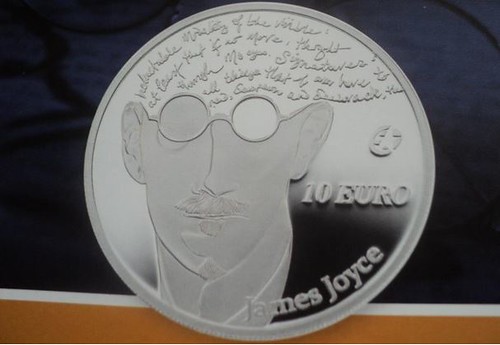
Tony Hine writes:
Bibliophiles with a numismatic bent will note that the Central Bank of Ireland is releasing a 38mm ten Euro coin in .925 silver on April 10. The website is www.centralbank.ie and the e-mail address is coinsets@centralbank.ie. Mintage at B.H. Mayers Mint is limited to 10,000.
At forty six Euros, these are not inexpensive, but owning a sculpted image of Joyce's signature "spectacles" (spectacles is Brit-speak for eyeglasses) and engraved script, will remind purchasers that the lyrical Joyce wrote to be read out loud, often phonetically creating slang and local dialect!
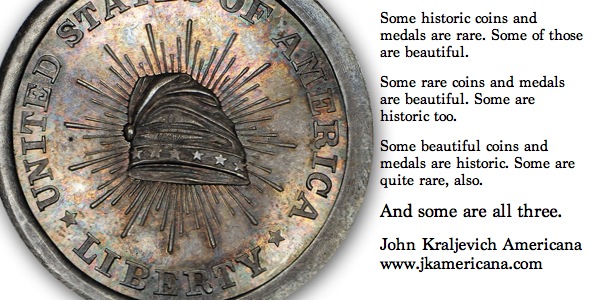
1934 ARTHUR HENDERSON NOBEL PRIZE MEDAL STOLEN
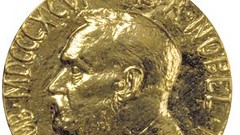 A £150,000 haul of valuables including a gold Nobel Peace Prize medal have been stolen during a raid at the lord mayor of Newcastle's mansion house.
A £150,000 haul of valuables including a gold Nobel Peace Prize medal have been stolen during a raid at the lord mayor of Newcastle's mansion house.
Police believe the raiders broke in through the cellar of the property in Fernwood Road in Jesmond overnight between Monday and Tuesday.
The medal was awarded to Newcastle's Arthur Henderson in 1934 for his work on international disarmament.
Supt Bruce Storey, of Northumbria Police, said: "Some of the items taken in this burglary are very uncommon and we are asking the public to keep their eyes open for them.
"One of the items is a Nobel Peace Prize, dating back to 1934 when it was awarded to Newcastle's Arthur Henderson for his work on international disarmament - it is extremely rare, recognisable and historically important."
The medal bears the inscription "Parlimentum Norvegial A Munro Henderson" and is with a presentation scroll in a leather case.
Other antique silverware taken includes silver cups dating back to 1919, a set of four Victoria napkin rings embossed with a star from 1875 and a William IV snuff box dating back to 1834.
Other valuables include a George II mustard pot from 1759 and a Queen Anne silver love cup engraved with the Queen Anne coat of arms.
To read the complete article, see: Nobel Peace Prize medal stolen in Newcastle (www.bbc.co.uk/news/uk-england-tyne-22008819)
To read the earlier E-Sylum article, see: MORE ON NOBEL PRIZE MEDALS (www.coinbooks.org/esylum_v16n10a10.html)
THE MAY 27, 2013 RAPP COIN AUCTION
Rapp Coin Auction
A coin auction of a particular kind.
 On May 27, 2013, the international auction house Rapp will conduct its second sale which exclusively offers coins and medals. It sticks to its principle. Only a few items will be offered as single lots. Most lots comprise entire collections. This makes it very likely for some lots to weigh as heavy as several kilograms. The focus will be on interesting lots with precious metals for investors. Ancient coins and medals from the 18th / 19th centuries, however, are likewise on offer.
If you are interested, don’t hesitate to attend the viewing of the lots. It will pay off – not only financially. Rapp Auctions is famous for its genuinely Swiss hospitality and its outstanding customer service!
On May 27, 2013, the international auction house Rapp will conduct its second sale which exclusively offers coins and medals. It sticks to its principle. Only a few items will be offered as single lots. Most lots comprise entire collections. This makes it very likely for some lots to weigh as heavy as several kilograms. The focus will be on interesting lots with precious metals for investors. Ancient coins and medals from the 18th / 19th centuries, however, are likewise on offer.
If you are interested, don’t hesitate to attend the viewing of the lots. It will pay off – not only financially. Rapp Auctions is famous for its genuinely Swiss hospitality and its outstanding customer service!
40 years of experience
The Auction house Rapp has gained a superb reputation with philatelists within more than 40 years. The company based in the small Swiss town of Wil ranges among the ten leading auctioneers for philately worldwide today. This house proudly holds a couple of records at once; like, for example, for the auction sale with the highest turnover in the history of philately: during that auction, over the course of eight days, stamps worth 33 million Swiss francs were auctioned off. Likewise the most expensive stamp of Switzerland, a Rayon I light blue with framed cross, was sold in 2008 for the world record price of 348’000 Swiss francs.
The starting prices comes to approximately 20% of the internal estimate Many bidders regularly attend the auction in person, since anyone who has ever been at a Rapp sale is well aware of the fact that the multiple lots will be called at 20% of the internal estimate. That promises good opportunities, notably for dealers and re-sellers. But the potential buyer must know than there has never been a lot sold for the starting price neither was any lot unsold. Prices rise rapidly, since many have calculated meticulously how much they can pay for a lot to make sure they still make a profit out of it.
From ancient to investor coins
As always, the offer will be worthwhile. Numismatically highly interesting lots will be offered for sale, as will be sets of bullion coins.
For example, we present two lots here, but naturally there is so much more to discover. Like, for example, a ‘numismatic collection with numerous world coins in one single lot. Including 42 gold coins.’ A number of the gold coins are numismatic rarities in attractive conditions, like a Friedrich d’or of Frederick the Great from 1775 in very fine to extremely fine; a double Friedrich d’or from 1839 in extremely fine; an extremely fine Saxon ducat from 1768; an extremely fine ducat from Hamburg from 1862, or a Bavarian ducat from 1816. What else is hidden in the ‘collectors stock’? Well, anyone interested has to find out for himself when attending the on-site viewing. By the way, this lot will be called out for 3’000 Swiss francs.
Our second example is a comprehensive collection featuring Chinese gold and silver coins, that were acquired at a time when no one expected a great potential of future collectors in China. It consists of ample series of commemorative coins in gold and silver or bimetal, respectively, including 30 gold coins whose fine gold content adds up to 250 grams in total, and more than 100 silver coins in addition. At the current market rate, the gold price alone amounts to much more than 10’000 euros – the calling will begin with 5,000 Swiss francs. Of course, the collector’s value isn’t even been taken into consideration here.
Viewing will pay off! But please be sure to register for it!
A thorough and meticulous viewing will surely pay off! But please remember that with the auction house Rapp things are a little bit different from what you might know from other coin auctions. We are afraid there is no way to look at the items rather spontaneously, right before the start of the sale. Even though, you can of course inspect at the day of the auction, but you are requested to register at any rate since the number of places is limited. Hence, make good use of the period prior to the auction. Take your time and examine the lots as of May 22, 2013. You may register via phone or simply via the internet.
Here you’ll be treated like a VIP!
Rapp provides its customers with a VIP service that is unheard-of in the numismatic world. If requested, the customers will be picked up by a chauffeur for free at the main station, either in Zurich or Wil, as well as – needless to say – at Zurich airport. During peak hours, however, it is better to take the train. It runs from Zurich Main Station or Zurich Airport, respectively, every 30 minutes. On the auction day, Rapp refunds all bidders the first-class rail ticket from Zurich to Wil.
Anyone in need for a hotel reservation may well approach Rapp, too. The auction café, which is already open during the viewing, will provide sustenance for free. And it goes without saying that the auction house Rapp arranges a magnificent entertainment program to the sale.
Please order your catalogue in time
Make sure to order your catalogue in time at Peter Rapp AG, Internationale Auktionen für Briefmarken & Münzen, Toggenburgerstrasse 139, P.O. Box 276, CH-9500 Wil, phone +41 / 71 / 923 77 44; fax: +41 / 71 / 923 92 20. Email: info@rapp-auktionen.ch. A protective charge will be invoiced for sending the catalogue: throughout Europe EUR 30; to overseas countries USD 40. The protective charge will be refunded at a purchase.
You will find the auction on the internet as well as at www.rapp-auktionen.ch as of May 1, 2013, at the latest.
Of course you can bid during the auction online or via the telephone (in real time).
Please read the terms of auction sale carefully. Here, too, there are some deviations from what you are used to. Dealers and collectors are treated equally: everyone pays an additional fee of 22%.
Things to know regarding the auction you will find at www.rapp-auktionen.ch
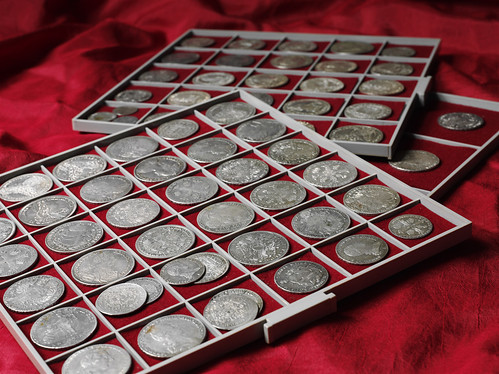
Old numismatic collection of coins from the Holy Roman Empire, all denominations with many rarities and many rare mints. Starting with Sigismund Rich in Coins and ending with the early commemorative coins of the Austrian Republic. In some cases extraordinary condition or rare types, like Republic of Venice 1848 5 lira in FDC, or double thaler Rudolph II, 1609, Ensisheim in extremely fine, Francis Joseph I etc. etc. Starting price: 3000.- CHF
Comprehensive numismatic collection comprising world coins to the euro. Included are 32 gold coins with more than 300 g fine gold, DM commemoration coins from Germanic museum till Fichte, DM circulation coins with 57 J and much more. Broad selection of high quality. Starting price: 2000.- CHF
 SWITZERLAND. 100 francs 1925 B. Extremely fine. Estimate: 5000.- to 6000.- CHF
SWITZERLAND. 100 francs 1925 B. Extremely fine. Estimate: 5000.- to 6000.- CHF
DAWSON LEWIS, MEDIEVAL MONEYER OF PIERRE, SD
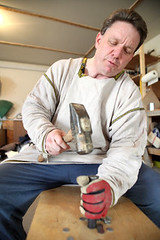 For most of his life Dawson Lewis has loved coins, be they modern American or ancient Roman. But today his love of metal money has evolved from simply collecting to designing and striking them himself.
For most of his life Dawson Lewis has loved coins, be they modern American or ancient Roman. But today his love of metal money has evolved from simply collecting to designing and striking them himself.
The hobby began as a desire to demonstrate for his son’s fourth-grade class, as they were studying about Rome, how the ancients made coins. After a few rough attempts to reproduce money on his own, a friend connected him with somebody in the Society for Creative Anachronism, a group dedicated to recreating now-obsolete processes, which Lewis joined soon after.
The rest, as they say, is history – well, re-created history.
“In the SCA people specialize in different crafts and stuff, and my geeky thing is the coins,” Lewis said.
Lewis makes them the way a coin-maker – technically a “moneyer” – living in 10th-century England would, although he works in inexpensive aluminum rather than the silver and gold of his medieval counterparts.
To mint the faux money, Lewis hammers a sheet of metal until it reaches a desired thinness, and then cuts out individual circles. Lewis does admit to cheating a bit, using a coin punch rather than doing it by hand.
The metal circles, or blanks, are then put between a top and bottom die. The dies are handmade by Lewis, who must painstakingly punch letters and forms onto them in reverse so the image on the coin isn’t backward. When the top die is struck with a hammer, the metal blank is pressed, creating the final product.
That method – hammering one at a time – is basically how coins were made from the time they were invented around 600 B.C. until A.D. 1500, Lewis said.
For the past several years Lewis has shown what he calls his “experimental archaeology” at various venues, including the Living History Fair in Brookings and the Midwest Viking Festival in Fargo, N.D. Recently he struck commemorative coins to honor the 40th Latin banquet in Pierre and its founder, Jay Mickelson.
By his estimates Lewis has made six or seven dies, and has individually struck several thousand coins. But he and a group of fellow enthusiasts once struck upward 10,000 coins to give away to school children for a single event. “Striking coins is kind of like eating potato chips – it’s hard to do just one,” he said.
To read the complete article, see:
Pierre man strikes coins using medieval methods
(www.capjournal.com/news/pierre-man-strikes-coins-using-medieval-methods
/article_7c0000a8-9dae-11e2-9016-0019bb2963f4.html)
THE BOOK BAZARRE
ROSARIO SHIPWRECK SITE YIELDS SILVER COINS AND GOLD BARS
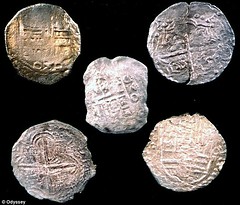 The stunning treasures from a sunken Spanish galleon have been revealed for the first time after the ship was rediscovered nearly 400 years on from its wreck in the Gulf of Mexico.
The stunning treasures from a sunken Spanish galleon have been revealed for the first time after the ship was rediscovered nearly 400 years on from its wreck in the Gulf of Mexico.
The loss of the Buen Jesus y Nuestra Senora del Rosario along with seven other ships destroyed the Bank of Madrid - and even contributed to the collapse of the Spanish Empire.
Now deep-sea divers believe they have found its wreck 400m deep, with 17,000 objects on board revealing that it was carrying gold, pearls - and even parrots.
The wreck site, around 400 miles from the Florida Keys, contains 39 gold bars, and nearly 1,200 silver pieces of eight.
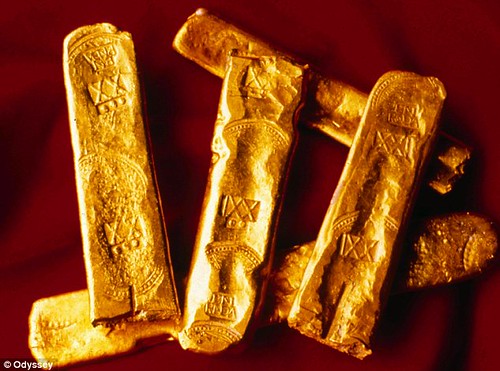
To read the complete article, see:
The treasure that sank the Spanish Empire: 400-year-old shipwreck reveals haul of gold, silver, pearls and even parrots
(www.dailymail.co.uk/news/article-2303830/The-treasure-sank-Spanish
-Empire-400-year-old-shipwreck-reveals-haul-gold-silver-pearls-parrots.html)
HOW MUCH GOLD IS THERE IN THE WORLD?
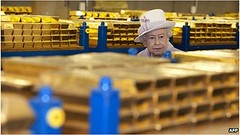 Imagine if you were a super-villain who had taken control of all the world's gold, and had decided to melt it down to make a cube. How long would the sides be? Hundreds of metres, thousands even?
Imagine if you were a super-villain who had taken control of all the world's gold, and had decided to melt it down to make a cube. How long would the sides be? Hundreds of metres, thousands even?
Actually, it's unlikely to be anything like that size.
Warren Buffett, one of the world's richest investors, says the total amount of gold in the world - the gold above ground, that is - could fit into a cube with sides of just 20m (67ft).
But is that all there is? And if so, how do we know?
A figure that is widely used by investors comes from Thomson Reuters GFMS, which produces an annual gold survey.
Their latest figure for all the gold in the world is 171,300 tonnes - which is almost exactly the same as the amount in our super-villain's imaginary cube.
A cube made of 171,300 tonnes would be about 20.7m (68ft) on each side. Or to put it another way, it would reach to 9.8m above ground level if exactly covering Wimbledon Centre Court.
But not everyone agrees with the GFMS figures.
Estimates range from 155,244 tonnes, marginally less than the GFMS figure, to about 16 times that amount - 2.5 million tonnes.
To read the complete article, see: How much gold is there in the world (www.bbc.co.uk/news/magazine-21969100)
KING OFFA'S PENNY
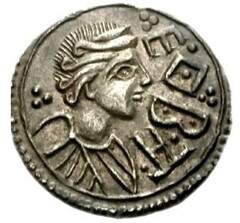 OFFA, the powerful 8th century king who made Tamworth his favourite habitat, left several lasting legacies – Offa's Dyke and the Diocese of Lichfield among them.
OFFA, the powerful 8th century king who made Tamworth his favourite habitat, left several lasting legacies – Offa's Dyke and the Diocese of Lichfield among them.
But his most enduring legacy, probably introduced to impress the great European emperor Charlemagne, King of the Franks, is an item so small that we rarely give it a second thought, even though it is still in everyday use.
Throughout the ages its size, weight and physical make-up has seen many changes, but the name remains the same – the penny.
It was about the year 785 when he introduced the silver penny, a coin that would impress his subjects and most of Europe.
Until then a coin called the sceat, which weighed 20 troy grains, was the most prolific coin used for trading, both in Britain and in mainland Europe. The new penny was very impressive, with different profiles of Offa's head embossed, along with different inscriptions, including 'Offa Rex', which simply means 'King Offa', and 'Rex Anglorum' which translates to 'King of the English'. There were several different portrayals of the great man, all intended to show him at his best.
He also had a coin struck portraying his wife, Queen Cynethryth, which was unique as no other queen in Anglo-Saxon times enjoyed such an honour.
The coins, probably struck at several different mints but mainly at Canterbury, weighed slightly heavier than the sceat, having a designated value of 24 troy grains (one pennyweight of silver or about 1.5 gms.).
A sum total of 240 of these sterling silver coins weighed one pound, hence the name £1 sterling.
To read the complete article, see:
King Offa's penny gift to posterity
(www.thisistamworth.co.uk/King-Offa-s-penny-gift-posterity/
story-18586912-detail/story.html#axzz2PYCpY2zv)
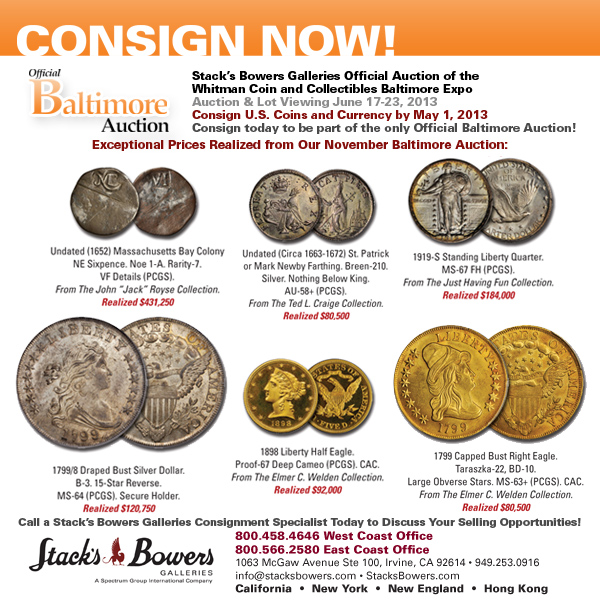
WON PARK, MASTER OF MONEY ORIGAMI
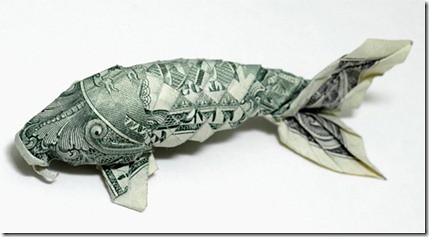
A friend sent me an email showing the art work of Won Park, a Master of Origami. I have never seen his work until now, but it needs to be shown everywhere. He does amazing work and all with just dollar bills. Here are some examples of his work… and some links to follow to see more..
Origami is the traditional Japanese art of paper folding. The goal of this art is to create a representation of an object using geometric folds and crease patterns preferably without the use of gluing or cutting the paper, and using only one piece of paper.
Won Park is the master of Origami. He is also called the “money folder”, a practitioner of origami whose canvas is the United States One Dollar Bill. Bending, twisting, and folding, Won Park creates life-like shapes inspired by objects living and not– both in stunning detail.
PS… the email that is currently circulating saves he lives in a renovated garbage truck…Not so, he’s living in Honolulu Hawaii, but the garbage truck looks pretty amazing and someone could live in it I suppose… ;o)
To read the complete article, see: Won Park Master of Origami (northbrookdesigns.blogspot.com/2010/04/won-park-master-of-origami.html)
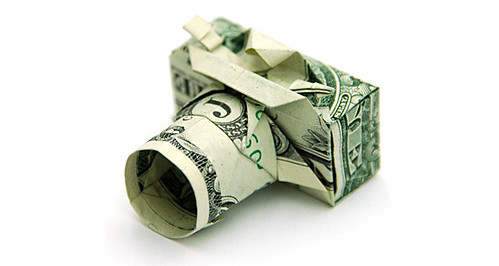

To read the complete article, see: Won Park – The Master of Origami Paper Folding (thedesigninspiration.com/articles/won-park-the-master-of-origami-paper-folding/)
FEATURED WEB PAGE: DAMNATIO MEMORIAE
This week's Featured Web Page is suggested by John Burns. Thanks! We were discussing politics in numismatics, and he mentioned a practice from ancient Rome that I was unaware of: Damnatio memoriae.
Damnatio memoriae is the Latin phrase literally meaning "condemnation of memory" in the sense of a judgment that a person must not be remembered. It was a form of dishonor that could be passed by the Roman Senate upon traitors or others who brought discredit to the Roman State. The intent was to erase someone from history, a task somewhat easier in ancient times, when documentation was much sparser.
The sense of the expression damnatio memoriae and of the sanction is to cancel every trace of the person from the life of Rome, as if he had never existed, in order to preserve the honour of the city; in a city that stressed the social appearance, respectability and the pride of being a true Roman as a fundamental requirement of the citizen, it was perhaps the most severe punishment.
Lucius Aelius Sejanus suffered damnatio memoriae following a failed conspiracy to overthrow emperor Tiberius in 31. His statues were destroyed and his name obliterated from all public records. The above coin from Augusta Bilbilis, originally struck to mark the consulship of Sejanus, has the words L. Aelio Seiano obliterated.
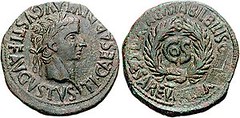
en.wikipedia.org/wiki/Damnatio_memoriae

